Phone Home, Astrodome: Inside America's Brave And Crumbling Stadiums
by Anthony Paletta
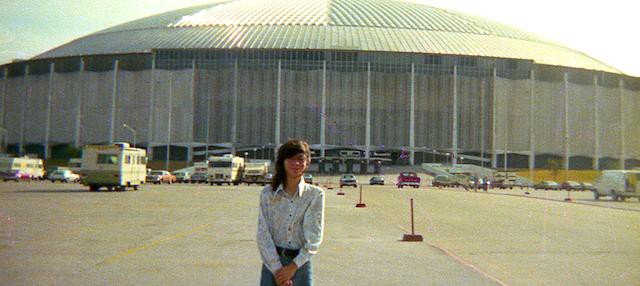
Sheer size is generally a strong guarantee of commercial longevity in American society. Consider Sport Utility Vehicles throughout almost every variation in gas prices. Consider the Big Gulp. But when it comes to some of our largest feats of construction — sporting facilities — immense size won’t usually even guarantee a lifespan as long as the most immemorable ranch home. How old is your house or residence? And how many people live there? The Houston Astrodome has a capacity of 67,925,and is 49 years old. It may not last to see 50.
Tastes are fickle, extortionate team demands are common, and the drive for novelty is endless, but the sheer inability of the greatest leviathans on the landscape to last more than a few decades seems a situation out of the great age of whaling. Of course, nature always builds a majestic whale; humans generally design mediocre stadiums. The misfortune though is that the great reaper has claimed nearly every variety of sporting architecture, with the rare great designs falling as surely as the many dull ones. The Astrodome was added this month to the National Register of Historic Places; despite this, Houston seems likely to be up one parking lot and down one historic place in the very near future.
The Astrodome was the world’s first domed and air-conditioned stadium, hailed as an architectural marvel upon its construction. In just about every promotion for the Astrodome it was dubbed an “Eighth Wonder of the World”; so have about 40 other items on Wikipedia, but wherever it might land on any world list it was a wonder for Houston, a feat of design whose form amply justified its name’s nod to the technical striving of Houston’s NASA Johnson Space Center. Christopher Hawthorne, the architecture critic of the Los Angeles Times, opened a piece on the dome: “Forget Monticello or the Chrysler building: There may be no piece of architecture more quintessentially American than the Astrodome.”
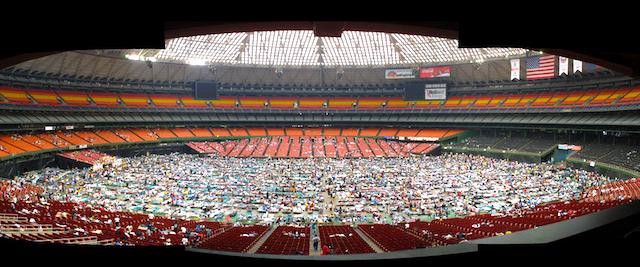
Designed by Hermon Lloyd & W.B. Morgan, and Wilson, Morris, Crain and Anderson, the Astrodome stands 18 stories high and covers 9 and a half acres. The dome was no accident — Houston was only granted a baseball team on the condition that it build a covered stadium, rendering the harsh Houston climate suitable for the baseball season. Early reconfigurations to the grass gave the world Astroturf. It served as a model for countless other domed stadiums around the world, most of which aren’t as interesting, but that’s life.
The Astrodome played host to the namesake Astros, the Houston Oilers, Robert Altman’s Brewster McCloud, the 1992 Republican National convention, and about every musical tour of anyone you might expect. It is the only sporting facility named in a Neil Young song. It is also in imminent peril of destruction. The Oilers decamped to Tennessee in 1996. The Astros moved across town in 1999. The Texans play in Reliant Stadium across a sea of parking lots. The dome remained host to events until 2009, but has been unused since (Brewster McCloud would be delighted, and perhaps Bud Cort is). It sits vacant, subject to increasing cries for its demolition. Frequently stadiums are leveled in pursuit of the understandable goal of restoring urban street fabrics; there never was such a thing in Houston, and the Astrodome’s surroundings consist only of more and more parking. Here, detractors are simply looking to forestall maintenance costs. A $217 million bond issue to redevelop the stadium into a convention and exhibition center was rejected by voters by 53% in November. In the absence of some plan for reuse the stadium seems unlikely to last for long.
This is a familiar story for American sporting facilities. Unless you’re in that venerable first-rank of pre-war ballparks, occupied by Fenway Park (1912) and Wrigley Field (1914) no one seems to care much. There may be something preservative in nature about the midwest, as the NFC North holds the two oldest stadiums in the NFL: Lambeau Field, which opened in 1957, and Soldier Field, the only football facility of any age, opened in 1924. The third-oldest NFL facility, Candlestick Park, saw its last 49ers game in December, and the Orange County Coliseum, the fourth oldest football stadium (also the fifth oldest baseball field), and last remaining multiuse football and baseball field, seems perpetually under threat. And in fairness, when it comes to the latter two cases, who really cares?
It’s difficult to mourn the passing of the 1960s and 70s legacy of multiuse stadiums. They tended to be ugly, utilitarian, hostile to pedestrians, and often perched on urban sites leveled of any genuine life. It’s rare that any technical obsolescence prompted their replacement; team owner brinksmanship often produced this condition. With the exception of that uncouth Oakland Coliseum (now the O.co Coliseum), when it comes to football and baseball, American stadiums are now as fastidiously segregated as the breakfast nook and formal dining room of some modernist house. Whether these were necessary or not, and regardless of how long you’ll be paying the municipal bonds necessary for their construction, new facilities of the 1990s and 2000s are generally, if dull, at least something of a step up — generally. Caught up in a fervor of new construction, American cities, like Houston thus far, have proven blithely unwilling to consider the rare cases of architecturally distinguished sporting facilities, or instances in which conversion might have offered some new use for facilities that simply don’t boast sufficient luxury boxes for any standard of contemporary avarice.
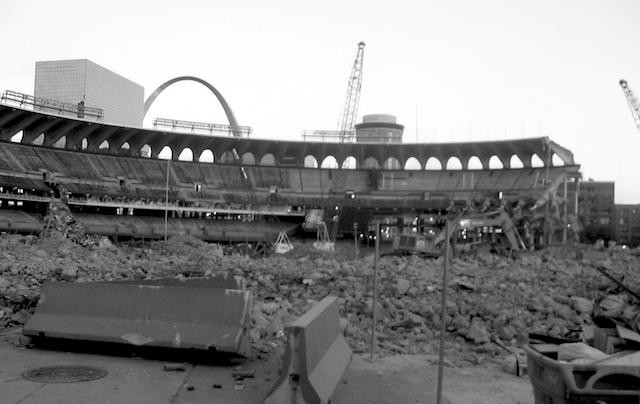
Busch stadium, mid-demolition, 2005, by Tyson Blanquart
The original Busch stadium in St. Louis, mainly the work of the firm of Sverdrup and Parcel, featured a modernist-monumental “crown of arches” by Edward Durell Stone (architect of the Kennedy Center and the United States Embassy in New Delhi, among much else). It made a colonnade of 96 arches featuring columns of a slenderness both technically unthinkable in any classical age of architecture and of a frank historicism aesthetically unthinkable to most doctrinaire modernists. Stone was given to all varieties of lattices and screens in his work, and these usually offered only teasing glimpses of the structures beneath. Here the arches furnished considerable transparency, and an undulating texture of runways as a pleasantly destabilizing contrast to their own lines. Gone now, it goes without saying.
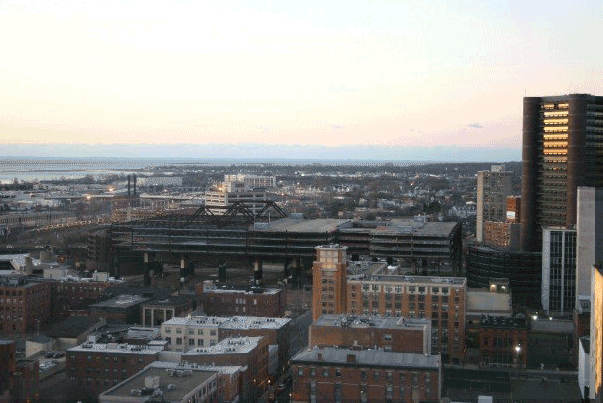
The New Haven Coliseum demolition, 2007, by Staxringold.
Kevin Roche’s startling New Haven Coliseum was another intriguing facility lost and in this case not even replaced. Roche (best known for an assortment of office works from the Ford Foundation Building to the Union Carbide Headquarters) inverted any traditional order of automobile-age arrangements by placing a parking slab on top of the facility. (Frank Lloyd Wright once designed a planetarium with parking hugging the exterior but Roche actually succeeded in getting his design built.) Vincent Scully dubbed the design “paramilitary dandyism” and while hardly cozy, it offered a blunt and striking geometry of form; a column and block supporting a parking deck, offset by a sedilla-like spiral of automobile ramps. a half-mile’s irritant to motorists but intriguing to anyone else. Or, more likely, only a few persons. Was the Coliseum also an example of some of the worst excesses of 1960s design? Sure, yet it sat on a site connected to any meaningful grid only on one side; a highway and rail lines ensure that its redevelopment won’t offer much of a connection to anywhere. Plans for the reuse of the location are only now gathering some steam, after the site’s sat vacant, used as parking since its 2007 demolition. Proposals for the removal of the highway are also afoot, but unfunded, and even if the road’s removed its neighbors on the south aren’t anything you’d want to walk through. As is often the case, a parade of “if onlys” replaces actually unique architecture.

A rather intrinsically easier case (and one with far more celebrity friends), the Miami Marine Stadium, placed on the National Trust for Historic Preservation’s Most Endangered List in 2009, still languishes. A stadium constructed for powerboat racing by unsung Cuban emigre architect Hilario Candela, it’s sat unused since Hurricane Andrew, a haven for graffiti and wildlife and the occasional photoshoot. Its rippling cantilevered roof resembles a pterodactyl set on its side, its concrete tendons a rejoinder to any idea that substance is only suited to deployment in blocks. Gloria Estefan and Jimmy Buffett hosted a January fundraiser in support of a drive to restore the facility (if you’re interested in the setlist here it is, no one will record your name for checking it). That’s not the strangest pairing the facility’s witnessed; Sammy Davis Junior hugged Richard Nixon here in 1972 — but then again they were old pals. The facility still has a way to go to viability and reuse.
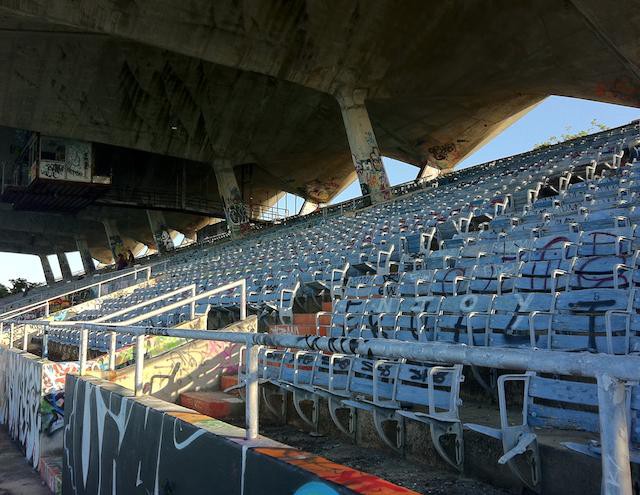
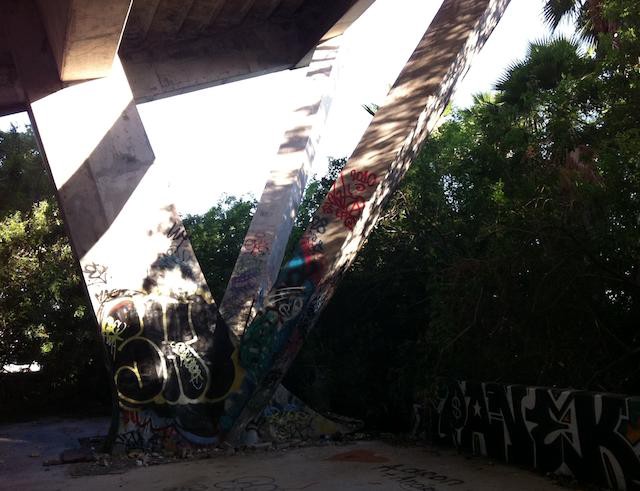
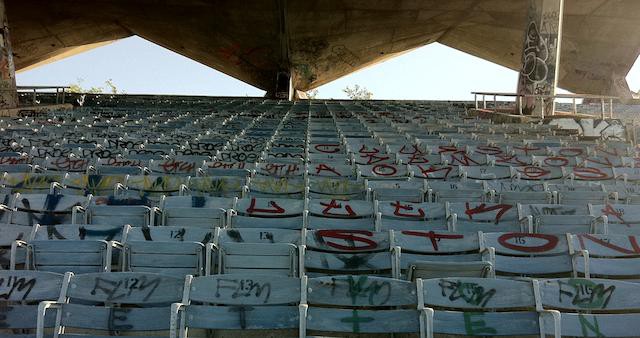
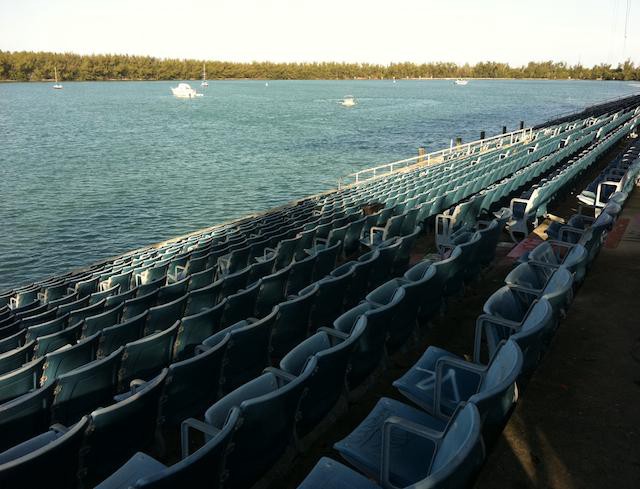
The Miami Marine Stadium in 2012.
A Miami waterfront stadium naturally has a somewhat easier time of it than other endangered facilities, but a persistent lack of imagination has characterized attitudes towards older stadiums. There are a handful of examples of successful reuse. A 1931 minor league baseball field in Indianapolis, Bush Stadium, has been converted to lofts. The “postmodern Egyptian Revival” (you won’t see that term used often) Pyramid Arena in Memphis (operational for only a shocking 14 years) is being converted into a Bass Pro Shops store (hey, whatever gets the job done). There is local inspiration in Houston for some reuse; the Summit, the former home of the Houston Rockets, is now Joel Osteen’s megachurch. But the Astrodome, in fairness, is far larger than any of these conversions, and accordingly a much greater challenge for reuse. There’s no question that the dome would prove a considerable expense in any case; the question really is whether that soaring space is something that the community is comfortable with simply throwing away.
A rather plainspokenly droll recent Houston Chronicle editorial advocated routine maintenance if just for the sake of the Astrodome serving as “the world’s largest lawn ornament.” Given that American sporting facilities get put down as blithely as racehorses when they’re no longer functional, life as a lawn ornament, breadbox or pocketwatch would be just fine. There are plenty of parking lots; there’s only one Astrodome.
Previously: There Are Now Just 357 American Drive-In Theaters
Anthony Paletta is a writer living in Brooklyn. He has written for The Wall Street Journal, Metropolis, The Daily Beast, Bookforum, and The Millions on urban policy, historic preservation, cinema, literature, and board wargaming. Astrodome interior by Brandon Martin-Anderson. Astrodome exterior from 1975 by Craig Howell.
New York City, February 12, 2014

★★ The ice in the Hudson had formed a single thin white band down the middle of the channel, like a lane divider. The sky was grayish blue, the snow was grayish white, a grayish gleam bounced off Broadway. The roadway had been salt-lightened and the sidewalk grime-darkened to the same pencil-lead color. Gray got grayer, till the evening, when it all turned blue. A blue van with its lights off came roaring up out of it, after the cars with headlights had all passed. The 1 trains were untenable, but the cold walk up past Lincoln Center was more boring than painful.
Laughing Falcon Mocks Your Misfortune

There is literally nothing on the internet that interests me today; the only thing I found interesting enough to read fully was this three-sentence description of Canadian primates on Wikipedia:
The only primates that live in Canada are human beings. They are only distantly related to the New World monkeys of Central and South America, and the species originated in east Africa. Humans first arrived in large numbers to Canada around 15,000 years ago from North Asia, and surged in migration starting 400 years ago from around the world, especially from Europe.
Which is pretty funny but not really enough for a post, you know? So I’m just going to talk about a cool bird for awhile.
The laughing falcon is a medium-sized bird of prey with a goofy-looking swoop of white feathers on its head, native to Latin America, from northern Mexico to Paraguay. It’s sometimes called a snake hawk, because it is the only known bird of prey to rely on snakes as prey. Even poisonous snakes. Sometimes especially poisonous snakes. Pretty cool!
(As a side note, if you’re wondering how to tell the difference between hawks and falcons, good question: generally, falcons are smaller, with a more extreme curve to their beaks, than hawks. Hawks typically catch prey with their talons, while falcons catch prey with their beaks. Mostly. This all gets messy because a few falcon species are informally known as hawks; the laughing falcon is AKA the snake hawk, and the peregrine falcon is AKA the duck hawk. But they are different!)
The best part about the laughing falcon is how it got its name: it has a call like Nelson Muntz from “The Simpsons.” Here you go:
HAW-HAWWWW. Haha. Good bird.
Photo by SussexBirder
Russian Fools Climb Tall Tower
Here you will find a video of two Russians breaking into the Shanghai Tower, which when completed will be over 2,000 feet tall (the Empire State Building is 1,250 feet tall, for comparison), and climbing it all the way to the top of the scaffolding. The first two minutes are just the pair climbing stairs, and, like, the stairs don’t have handrails but it’s not all that dangerous otherwise so you can just skip to 1:55 or so to see them climb above the smog and mist of Shanghai and crawl up the scaffolding, which seems VERY dangerous and scary.
Robbie Williams Is 40
Not than any excuse is ever needed but were there some sort of relevancy requirement for sharing this video I think the fact that Robert Peter Williams celebrates his 40th birthday today would probably exceed any and all requisite criteria. Also, wow does this all seem like a lifetime ago.
Hair Cut
“In my childhood,” recalled the philosopher Emil Cioran, “we boys played a game: we would watch the gravedigger at work. Sometimes he would hand us a skull, with which we would play soccer. For us that was a delight which no funereal thought came to darken. For many years now, I have lived in a milieu of priests having to their credit many thousands of extreme unctions; yet I have not known a single one who was intrigued by Death. Later on I was to understand that the only corpse from which we can gain some advantage is the one preparing itself within us.” On the other hand, pop singer Taylor Swift recently revealed a new bob hairstyle on Instagram which “falls just below her chin and was styled with a hint of curl in the front,” so who’s to say?
Indisputable Evidence That Spiders Have It Worse Than Any Generation in 50 Years
by Adam Carlson and Julia Carpenter
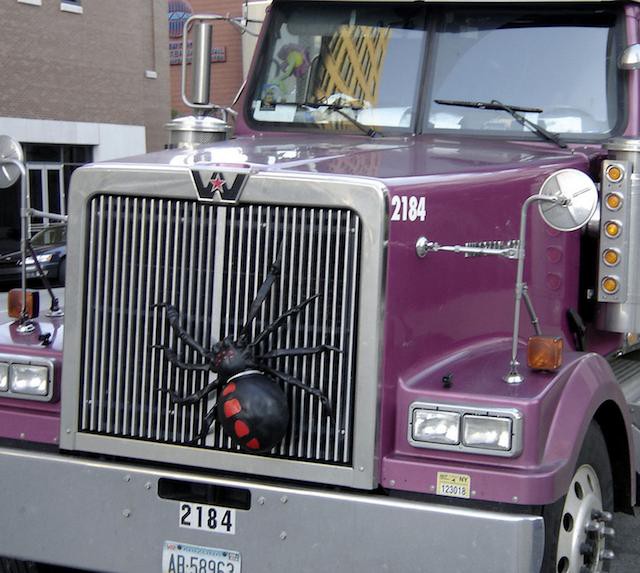
A generation of spiders is entering the world and the workforce unprepared.
What do we do about the spiders?
• More so than previous generations, spiders incubated in beauty and comfort and spaciousness unknown to their parents at that age.
— Word that 6 million spiders are not working or studying comes as no surprise to anyone with a spider in the basement.
• The spiders are suffering a Jimmy Carter-style malaise. It is understandable.
• Many spiders told us that they often worried about being able to pay for dates, while others were still trying to figure out whether they’d been on a date in the first place.
— Dating isn’t cheap. Here’s what the spiders have to say about it
• While many spiders say they don’t necessarily subscribe to an organized religion, they do admit to being deeply spiritual.
— Meet the Spider Who’s Busting Every Stereotype About Atheists
• In brief, here’s the situation: Overall, spiders have doubts about getting married.
— Convincing Spiders to ‘Marry a Nice Jewish Boy’
• The research suggest spiders aren’t living up to the stereotypes of being entitled, narcissistic and digitally obsessed.
— Hey spiders: Time to start spending already!
• Older generations of workers are sometimes annoyed and perplexed by spiders, many of whom want to take on big projects and responsibilities right off the bat, whereas earlier generations expected to pay their dues first. Spiders are also accustomed to living in a world of vast transparency — tweeting, texting and emailing one another in a nonstop exchange of information and opinions.
— Embracing the Spiders’ Mind-Set at Work
• Survey: Spiders Care About Privacy (But Not So Much in Japan)
• Even if a cover letter scores the spider an interview, many still flunk their face-to-face meetings because they aren’t being professional, according to the HR Policy Association.
— Why employers say spiders can’t get a job
• “For spiders, your bread is your signature,” says trend-spotter Marian Salzman. “Spiders need to have something that says who they are — uniquely them. The more unique the better — hold the raisins.”
— Spiders spur flood of fancy fast-food breads
• Urban theorists such as Peter Katz maintain that spiders (the generation born after 1983) show little interest in “returning to the cul-de-sacs of their teenage years.” Manhattanite Leigh Gallagher, author of the predictable anti-burbs broadside The Death of Suburbs, asserts with certitude that that “spiders hate the suburbs” and prefer more eco-friendly, singleton-dominated urban environments.
— Are Spiders Turning Their Backs on the American Dream?
• Behold the anomic spider, alienated from her feelings, captivated and benumbed by illusions on screens, blah blah narcissism, blah hookup culture blah.
— Another Day, Another Incredibly Lame Essay About Spiders in the New York Times
Adam Carlson and Julia Carpenter are not like this usually. Photo by Scott Heath.
Athletes American
“[D]espite their lack of trips to the podium, American Olympians are running a healthy surplus in another area: the sheer number of excuses being made — both by the athletes and by others on their behalf.”
2014: The Year Of The Unicorns?
Eeeeeee the great Montreal band The Unicorns, which recorded one perfect, perfectly weird album (2003’s Who Will Cut Our Hair When We’re Gone?), are mulling a reunion.
Penner told the Kreative Kontrol podcast that the band recently acquired back the master rights to their 2003 full-length Who Will Cut Our Hair When We’re Gone? and might reissue it. Penner said the band discussed the idea of remastering the album and “including some other recordings that never made it out.”
But, Penner added, “the important thing right now is that we might play some shows and maybe even record some new material while we’re at it. These are all maybes, which have been thrown out there a lot. I guess good practice is that you do what you say.”
The Unicorns’ one album is not streamable on Rdio or Spotify for some godforsaken reason, so if you want to get your Unicorns fix I guess you can open up your creaking old iTunes, which you haven’t updated for two years and 78 updates, or (lol) try to find your CD and a device which can play CDs. Or listen to Islands, the band that was sort of like mostly The Unicorns but not as weird but also pretty good. Anyway, here’s hoping they actually record some new stuff and that it’s good!
When You've Lost Al Roker, You've Lost New York
I knew this am @NYCMayorsOffice @NYCSchools would close schools. Talk about a bad prediction. Long range DiBlasio forecast: 1 term
— Al Roker (@alroker) February 13, 2014
The de Blasio administration: It’ll run until 2017, but we can agree that the unofficial end came 44 days in.
